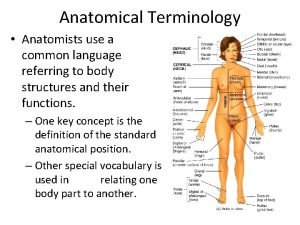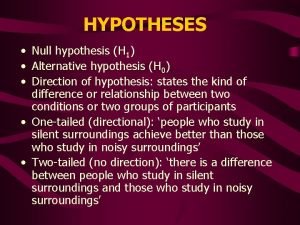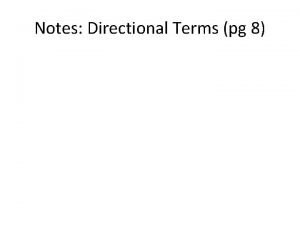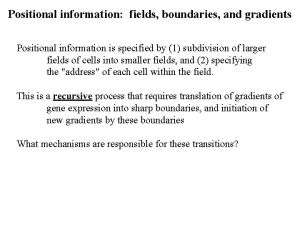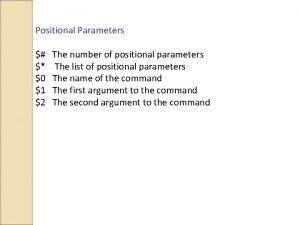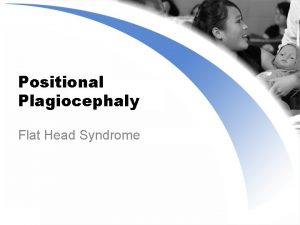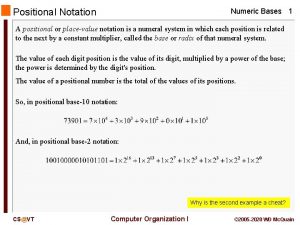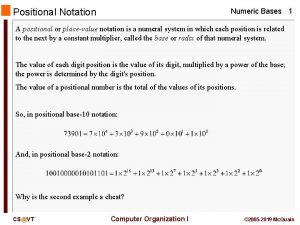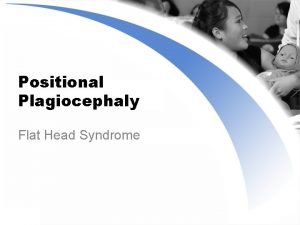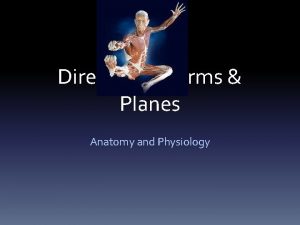Positional and Directional Terms DEFINITIONS n Anatomy the

















- Slides: 17

Positional and Directional Terms

DEFINITIONS n Anatomy – the study of the structures of the body (ex. - names of bones) n Physiology – the study of the functions of these structures (ex. - role of bones in the musculoskeletal system)

ANATOMICAL POSITION ALL descriptions of the body are based on anatomical position. When referring to anatomical position, that means the person is: 1. Standing 2. Facing toward you 3. Arms at their sides 4. Palms toward you n

PLANES OF THE BODY n Midsagittal (lateral) – lengthwise plane that divides the body into equal right and left sides n Sagittal (lateral) – divides the body into unequal right and left sides

PLANES OF THE BODY n Frontal (coronal) - plane that divides the body into front and back portions n Transverse (horizontal) - plane that divides the body into upper and lower portions

POSITIONAL & DIRECTIONAL TERMS Please turn to page 22, Table 2. 1 n. Ventral – front or belly side n. Anterior – situated in front n. Superior – above, toward the head n. Cephalic – toward the head n. Proximal – near the midline or beginning of a structure n. Medial – toward, near the midline

POSITIONAL & DIRECTIONAL TERMS Dorsal – back of body or organ n Posterior – situated in back n Inferior – below, toward the feet n Caudal – toward lower part of body n Lateral – away from the midline n Distal – farthest from midline or beginning of a structure n

POSITIONAL & DIRECTIONAL TERMS Remember: ALL terms are used in relation to what body part they are being compared to Example: The ankle is ( ) to the knee?

BODY CAVITIES n Spaces within the body that contain and protect internal organs n Dorsal Cavities (back of the body): Cranial - contains brain, pituitary gland n Spinal - nerves, spinal cord n

BODY CAVITIES n Ventral Cavities (front of the body): Thoracic - contains heart, lungs, esophagus, trachea, bronchial tubes, thymus, aorta n Abdominal - stomach, small & large intestine, spleen, pancreas, liver, gallbladder n Pelvic - portion of large & small intestine, rectum, urinary bladder, urethra, ureters, uterus, vagina n

DIVISIONS OF THE ABDOMEN RUQ – right upper quadrant RLQ – right lower quadrant RUQ RLQ LUQ LLQ LUQ – left upper quadrant LLQ – left lower quadrant Abdomin/o/pelv/ic area is divided into four quadrants n Assessment findings, organs, etc… are described by the quadrant they are located in n

ORGANS IN THE QUADRANTS OF THE ABDOMINOPELVIC AREA n RUQ - liver, gallbladder, part of pancreas, part of small & large intestine n LUQ - liver, stomach, spleen, part of pancreas, part of small & large intestine

ORGANS IN THE QUADRANTS OF THE ABDOMINOPELVIC AREA n RLQ - part of small and large intestine, right ovary & fallopian tube, right ureter, and appendix n LLQ - part of small and large intestine, left ovary & fallopian tube, left ureter

ABDOMINOPELVIC REGIONS n Named for the PATIENT’s side of body (i. e. his right or left, NOT yours) n Right hypochondriac n Epigastric n Left hypochondriac n Right lumbar n Umbilical n Left lumbar n Right inguinal n Hypogastric n Left inguinal

ABDOMINOPELVIC REGIONS Right Hypochondriac Right Lumbar Right Inguinal Epigastric Left Hypochondriac Umbilical Left Lumbar Hypogastric Left Inguinal

BODY CAVITIES n Divisions of Abdominal cavity n The peritoneum is a membrane surrounding the organs in the abdominal cavity. n The retroperitoneal (retro- = behind) area is behind the peritoneum and contains the kidneys.

Time to Practice!!! n n You will be divided into groups. In your group, create a fictional medical story using the following guidelines: n must use one “plane” of the body n n n must use four position or directional terms must contain two ventral cavity organs must contain one quadrant and one abdominopelvic region Present your story to the class in the form of a skit. You will have 20 minutes to prepare your story & skit. Your story must make sense and contain correct use of the terms.
 Anatomical terms
Anatomical terms Positional and directional terms
Positional and directional terms Positional and directional terms
Positional and directional terms Directional terms anatomy
Directional terms anatomy Body organization and terminology lab 2
Body organization and terminology lab 2 Planes of the body
Planes of the body Directional hypothesis example
Directional hypothesis example Example of statement of the problem in research
Example of statement of the problem in research Directional and non directional hypothesis
Directional and non directional hypothesis Formulating and clarifying the research topic
Formulating and clarifying the research topic Directional and non directional hypothesis
Directional and non directional hypothesis Directional and non directional hypothesis
Directional and non directional hypothesis Directional hypothesis example
Directional hypothesis example Gummy bear regional and directional terms review
Gummy bear regional and directional terms review Body directional terms
Body directional terms Carburizing flame definition
Carburizing flame definition A quick primer
A quick primer Undefined terms worksheet
Undefined terms worksheet





